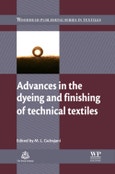The use of distinctive colourants and finishes has a significant impact on the aesthetic appeal and functionality of technical textiles. Advances in the textile chemical industry facilitate production of diverse desirable properties, and are therefore of great interest in the production of textile products with enhanced performance characteristics. Drawing on key research, Advances in the dyeing and finishing of technical textiles details important advances in this field and outlines their development for a range of applications.
Part one reviews advances in dyes and colourants, including chromic materials, optical effect pigments and microencapsulated colourants for technical textile applications. Other types of functional dyes considered include UV- absorbent, anti-microbial and water-repellent dyes. Regulations relating to the use of textile dyes are discussed before part two goes on to investigate such advances in finishing techniques as mechanical finishing, softening treatments and the use of enzymes. Surfactants, Inkjet printing of technical textiles and functional finishes to improve the comfort and protection of apparel are also explored. The use of nanotechnology in producing hydrophobic, super-hydrophobic and antimicrobial finishes is dealt with alongside coating and lamination techniques, before the book concludes with a discussion of speciality polymers for the finishing of technical textiles.
With its distinguished editor and international team of expert contributors, Advances in the dyeing and finishing of technical textiles is a comprehensive guide for all those involved in the development, production and application of technical textiles, including textile chemists, colour technologists, colour quality inspectors, product developers and textile finishers.
Please Note: This is an On Demand product, delivery may take up to 11 working days after payment has been received.
Table of Contents
Contributor contact details
Woodhead Publishing Series in Textiles
Part I: Advances in dyes and colourants
Chapter 1: Chromic materials for technical textile applications
Abstract:
1.1.1 An overview of chromic materials
1.2 Thermochromism
1.3 Photochromism
1.4 lonochromism
1.5 Electrochromism
1.6 Miscellaneous chromic materials
1.7 Future trends
1.8 Sources of further information
Chapter 2: Optical effect pigments for technical textile applications
Abstract:
2.1 Introduction
2.2 Different types of pigments and dyes
2.3 Substrate-based effect pigments
2.4 Future trends
Chapter 3: UV-absorbent, antimicrobial, water-repellent and other types of functional dye for technical textile applications
Abstract:
3.1 Introduction
3.2 High light-fast dyes dyes with inbuilt UV-absorbing units
3.3 Antimicrobial dyes
3.4 Water-repellent dyes and other fluorine-containing functional dyes
3.5 Biodegradable dyes
3.6 Fluorescent dyes and phosphorescent colorants
3.7 Future trends
Chapter 4: Microencapsulated colourants for technical textile application
Abstract
4.1 Introduction
4.2 The fundamentals of microencapsulation technology
4.3 Applications in textile printing
4.4 Applications in textile processing
4.5 Miscellaneous applications of microencapsulated colourants
4.6 Commercially available products
4.7 Future trends
Chapter 5: Regulations relating to the use of textile dyes and chemicals
Abstract:
5.1 Introduction
5.2 Restricted substances and their regulation
5.3 Retailer standards and ecolabels
5.4 Registration, Evaluation and Authorisation of Chemicals (REACH)
5.5 Future trends
Part II: Advances in finishing techniques
Chapter 6: Mechanical finishing techniques for technical textiles
Abstract:
6.1 Introduction
6.2 Dry finishing techniques
6.3 Calendering
6.4 Wet finishing techniques
6.5 Mechanical finishing technologies and applications
6.6 Sources of further information and advice
Chapter 7: Softening treatments for technical textiles
Abstract:
7.1 Introduction
7.2 Methods of softening
7.3 Chemistry of softeners
7.4 Application of softeners to technical textiles
7.5 Effect of softeners on textile properties
7.6 Environmental impact of softeners
7.7 Measurement of fabric softness
7.8 Future trends
Chapter 8: The use of enzymatic techniques in the finishing of technical textiles
Abstract:
8.1 Introduction: use of enzymes in textile finishing
8.2 Enzymatic processing of natural fibres
8.3 Surface modification and functionalization of synthetic fibres
8.4 Application of enzymes in the finishing of technical textiles
8.5 Assessment techniques and future trends
Chapter 9: The use of surfactants in the finishing of technical textiles
Abstract:
9.1 Introduction
9.2 Raw materials for surfactants
9.3 Cationic and non-ionic surfactants
9.4 Novel surfactants
9.5 Applications of surfactants
9.6 Conclusion
Chapter 10: Inkjet printing of technical textiles
Abstract
10.1 Introduction
10.2 Development of printer hardware for inkjet printing of textiles
10.3 Ink chemistry for technical textiles
10.4 Development of auxiliary equipment and supporting software
10.5 Trends in technology development
10.6 Technology application
10.7 Conclusion
Chapter 11: Functional finishes to improve the comfort and protection of apparel
Abstract
11.1 Introduction
11.2 Finishes to improve comfort
11.3 Finishes to provide protection
11.4 Comfort and health issues related to textile finishes
11.5 Future trends
Chapter 12: The use of nanotechnology in the finishing of technical textiles
Abstract:
12.1 Introduction
12.2 Hydrophobic nano-finishes
12.3 Super-hydrophobic nano-finishes
12.4 Photocatalytic self-cleaning nano-finishes
12.5 Antimicrobial nano-finishes
Chapter 13: Speciality polymers for the finishing of technical textiles
13.1 Introduction
13.2 Temperature responsive breathable coatings for smart textiles
13.3 Bioactive finishes for protection against biological attack and other medical applications
13.4 Finishes for protection against flame and thermal radiation
13.5 Repellent, release, hydrophobic and self-cleaning finishes
13.6 Finishes for conducting textiles
13.7 Other functional finishes
13.8 Conclusions and future trends
Chapter 14: Application technologies for coating, lamination and finishing of technical textiles
Abstract:
14.1 Introduction
14.2 Coating technology
14.3 Roll coating
14.4 Lamination methods
14.5 Finishing methods
14.6 Plasma processing
14.7 Plasma system classification
14.8 Advances in application of speciality finishes/coatings
14.9 Conclusion
14.10 Acknowledgements
Index








